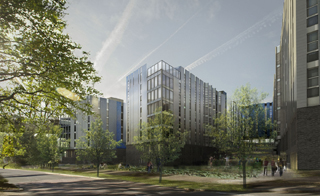|
Subscribe / Renew |
|
|
Contact Us |
|
| ► Subscribe to our Free Weekly Newsletter | |
| home | Welcome, sign in or click here to subscribe. | login |
Construction
| |
 |
August 23, 2012
UW’s Mercer Court aims to keep students socially connected
Ankrom Moisan and Gustafson Guthrie Nichol

Heater
|

Guthrie
|
The University of Washington’s 40-year-old Mercer Hall was outdated and dark, and ready to come down.
Its replacement, the Mercer Court Apartments, will be a five-building, 900-bed complex at Eastlake Avenue Northeast and Northeast Pacific Street. Construction is under way and the complex is scheduled to open in the fall of 2013.
Research has shown that students who live on campus stay in school longer and do better academically. But all too often, student housing has been seen as merely convenient and not much more.
Mercer Court, which has an urban farm, six-bedroom apartment suites and interactive public spaces, offers innovative student housing that enables students to thrive as they develop new relationships and find their place in the campus community.
Social spaces
The design of Mercer Court is based on the idea of creating community at every scale of the project. Located in the university’s growing west campus area, Mercer Court aims to be an exciting, socially vibrant home that is immersed in the amenities of the campus community.
A variety of spaces, starting with the individual unit and extending to public plazas and an active urban farm, provide opportunities for students to connect with friends, meet people, explore new ideas and share experiences. These community spaces, in turn, interact with each other and feed into the campus as a whole.
The location, overlooking Portage Bay and adjacent to the Burke-Gilman recreational trail, helped determine the building massing, which in the plan resembles an open hand with outstretched fingers reaching toward the water.
The site’s main plaza performs as the palm of the hand, framed by the buildings to provide a central gathering and event space as well as to be the common ground for student circulation.
The main building runs along the bike path and anchors the project with an active pedestrian edge that features a strong retail component. The strategically placed building fingers celebrate views of the water from all units and allow plenty of light to filter into the courtyards and buildings.
Creating community

The creation of community begins with the design of the individual units, which range from studios to six-bedroom, six-bath apartments. The largest units anchor the end of each finger, capturing prime views.
These apartments were championed by English design firm Feilden Clegg Bradley Studios, who collaborated with architect of record Ankrom Moisan and landscape architect Gustafson Guthrie Nichol.
Interviews with students in England have shown that apartments with six bedrooms (as opposed to the traditional two or four) provide greater potential for creating community because individual students have more opportunity to connect with their own suitemates. Each apartment contains a shared living, dining and kitchen space with spectacular views of the bay and the Seattle skyline.
These large units are grouped around individual stair-and-elevator cores that connect each end portion of the buildings vertically, from the rooftop terrace down to the ground-floor exterior arcade. The arcade then provides access to amenity areas like study rooms, a music room, secure bike storage and the large main plaza.
The plaza serves as the community living room and links to communitywide amenities such as the great room, a green laundry room, meeting rooms and a new coffee shop. The cafe is open to the public and has outdoor seating on a sunlit terrace, offering a convenient meeting place for students as well as cyclists, joggers, walkers and skaters along the adjacent recreational trail.
An urban farm
The landscape plan capitalizes on the site’s extreme south-sloping topography to create spaces of varied intimacy for people to meet and connect. These include the socially vibrant mixing zone at the cafe, strategically located outdoor lounges at the building entries, and intimate seating areas sprinkled throughout Mercer Court’s terraced landscape.
The main plaza includes flexible spaces for events such as concerts, farmers’ markets and student rallies. The most innovative element of the outdoor terraces is a year-round working urban farm.
The farm, operated by UW Farm, is a student-run enterprise that plants, maintains and harvests produce on campus. The UW Farm plans to set up farm stands in the neighborhood to sell their products — not only to support the program but also as a community-outreach and public-education endeavor. Leveraging Seattle’s mild climate, the farm will be actively managed and productive in all four seasons.
Underneath the site, the largest rainwater cistern on a university campus will store water collected from the building roof drains. By providing nearly all the water for the building’s laundry facility, the cistern will save an estimated 627,000 gallons of potable city water each year.
The project is being built with five levels of wood using advanced framing techniques that maximize insulation within the wall for energy efficiency. The wood levels sit atop three levels of concrete structure that are built into the slope, accommodating parking along with day lit units.
The plaza level marks a horizontal datum — a “waterline” — for the project. Below this line, dark rusticated clinker brick is used to surround the farm. Above the waterline, the crisp edges of the fingers are wrapped in a reflective metal skin.
The windows are popped out with flippers at various locations within the center of the buildings to take advantage of views. The ends of each finger also contain a study room and exterior deck for all residents to enjoy the best view from the site.
Dave Heater is a managing principal of Ankrom Moisan’s Seattle office, and has spent the majority of his 20-year career on market-rate urban housing. Jennifer Guthrie is a founding partner of Gustafson Guthrie Nichol. Her work ranges from neighborhood-scale to larger public works.
Other Stories:
- 5 tips to help districts with their long-range plans
- School contractors face new scrutiny from taxpayers
- Skills centers making inroads in Washington
- Schools can stretch facilities budgets by embracing technology
- Laser scanning: a powerful tool for school projects
- Portables aren’t the last word in modular schools
- Schools face pressure to keep up with tech trends
- Online learning will have lasting effect on campus spaces



